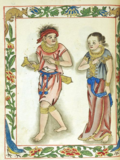Nobility
This articleneeds additional citations forverification.(August 2020) |

Nobilityis asocial classfound in manysocietiesthat have anaristocracy.It is normally ranked immediately belowroyalty.Nobility has often been anestate of the realmwith many exclusive functions and characteristics. The characteristics associated with nobility may constitute substantial advantages over or relative to non-nobles or simply formal functions (e.g.,precedence), and vary by country and by era. Membership in the nobility, including rights and responsibilities, is typicallyhereditaryandpatrilineal.
Membership in the nobility has historically been granted by a monarch or government, and acquisition of sufficient power, wealth, ownerships, or royal favour has occasionally enabled commoners to ascend into the nobility.[1]
There are often a variety of ranks within the noble class. Legal recognition of nobility has been much more common in monarchies, but nobility also existed in such regimes as theDutch Republic(1581–1795), theRepublic of Genoa(1005–1815), theRepublic of Venice(697–1797), and theOld Swiss Confederacy(1300–1798), and remains part of the legal social structure of some small non-hereditary regimes, e.g.,San Marino,and theVatican Cityin Europe. InClassical Antiquity,thenobiles(nobles) of theRoman Republicwere families descended from persons who had achieved theconsulship.Those who belonged to the hereditarypatrician familieswere nobles, butplebeianswhose ancestors were consuls were also considerednobiles.In theRoman Empire,the nobility were descendants of this Republican aristocracy. While ancestry of contemporary noble families from ancient Roman nobility might technically be possible, no well-researched, historically documented generation-by-generation genealogical descents from ancient Roman times are known to exist in Europe.[citation needed]
Hereditary titlesandstylesadded to names (such as "Prince", "Lord", or "Lady" ), as well ashonorifics,often distinguish nobles from non-nobles in conversation and written speech. In many nations, most of the nobility have been untitled, and some hereditary titles do not indicate nobility (e.g.,vidame). Some countries have had non-hereditary nobility, such as theEmpire of Brazilorlife peersin theUnited Kingdom.
History[edit]


The term derives from Latinnobilitas,theabstract nounof the adjectivenobilis( "noble but also secondarily well-known, famous, notable" ).[2]Inancient Roman society,nobilesoriginated as an informal designation for the political governing class who had allied interests, including bothpatriciansandplebeian families(gentes)with an ancestor who had risen to theconsulshipthrough his own merit (seenovus homo,"new man" ).
In modern usage, "nobility" is applied to the highest social class inpre-modern societies.[3]In thefeudal system(in Europe and elsewhere), the nobility were generally those who held afief,often land or office, undervassalage,i.e., in exchange forallegianceand various, mainly military, services to asuzerain,who might be a higher-ranking nobleman or a monarch. It rapidly became a hereditarycaste,sometimes associated with a right to bear a hereditary title and, for example in pre-revolutionary France, enjoying fiscal and other privileges.
While noble status formerly conferred significant privileges in most jurisdictions, by the 21st century it had become a largely honorary dignity in most societies,[4]although a few, residual privileges may still be preserved legally (e.g. Spain, UK) and some Asian, Pacific and African cultures continue to attach considerable significance to formal hereditary rank or titles. (Compare the entrenched position andleadershipexpectations of the nobility of the Kingdom ofTonga.) More than a third ofBritish landis in the hands of aristocrats and traditionallanded gentry.[5][6]
Nobility is a historical, social, and often legal notion, differing from highsocio-economic statusin that the latter is mainly based on pedigree, income, possessions, orlifestyle.Being wealthy or influential cannotipso factomake one noble, nor are all nobles wealthy or influential (aristocratic families have lost their fortunes in various ways, and the concept of the 'poor nobleman' is almost as old as nobility itself).
Although many societies have a privilegedupper classwith substantial wealth and power, the status is not necessarily hereditary and does not entail a distinctlegal status,nor differentiatedforms of address.Various republics, including European countries such as Greece, Turkey, and Austria, and formerIron Curtaincountries and places in the Americas such asMexicoand theUnited States,have expressly abolished the conferral and use of titles of nobility for their citizens. This is distinct from countries that have not abolished the right to inherit titles, but which do not grant legal recognition or protection to them, such as Germany and Italy, although Germany recognizes their use as part of the legal surname. Still, other countries and authorities allow their use, but forbid attachment of any privilege thereto, e.g., Finland, Norway, and the European Union,[citation needed]while French law also protects lawful titles againstusurpation.
Noble privileges[edit]
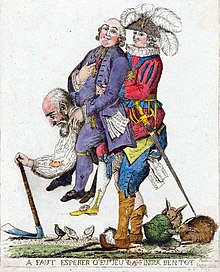
Not all of the benefits of nobility derived from noble statusper se.Usually privileges were granted or recognized by themonarchin association with possession of a specific title, office or estate. Most nobles' wealth derived from one or moreestates,large or small, that might include fields, pasture, orchards, timberland, hunting grounds, streams, etc. It also included infrastructure such as a castle, well and mill to which local peasants were allowed some access, although often at a price. Nobles were expected to live "nobly", that is, from the proceeds of these possessions. Work involvingmanual laboror subordination to those of lower rank (with specific exceptions, such as in military or ecclesiastic service) was either forbidden (as derogation from noble status) or frowned upon socially. On the other hand, membership in the nobility was usually a prerequisite for holding offices of trust in the realm and for career promotion, especially in the military, at court and often the higher functions in the government, judiciary and church.
Prior to theFrench Revolution,European nobles typically commanded tribute in the form of entitlement to cash rents or usage taxes, labor or a portion of the annual crop yield fromcommonersor nobles of lower rank who lived or worked on the noble'smanoror within hisseigneurialdomain. In some countries, the local lord could impose restrictions on such a commoner's movements, religion or legal undertakings. Nobles exclusively enjoyed the privilege ofhunting.In France, nobles were exempt from paying thetaille,the major direct tax. Peasants were not only bound to the nobility by dues and services, but the exercise of their rights was often also subject to thejurisdictionof courts and police from whose authority the actions of nobles were entirely or partially exempt. In some parts of Europe the right ofprivate warlong remained the privilege of every noble.[7]
During the early Renaissance,duellingestablished the status of a respectablegentlemanand was an accepted manner of resolving disputes.[8]
Since the end of World War I the hereditary nobility entitled tospecial rightshas largely been abolished in theWestern Worldas intrinsicallydiscriminatory,and discredited as inferior in efficiency to individualmeritocracyin the allocation of societal resources.[9]Nobility came to be associated with social rather than legal privilege, expressed in a general expectation of deference from those of lower rank. By the 21st century even that deference had become increasingly minimized. In general, the present nobility present in the European monarchies has no more privileges than the citizensdecoratedin republics.
Ennoblement[edit]

In France, aseigneurie(lordship) might include one or more manors surrounded by land and villages subject to a noble's prerogatives and disposition.Seigneuriescould be bought, sold or mortgaged. If erected by the crown into, e.g., a barony or countship, it became legallyentailedfor a specific family, which could use it as their title. Yet most French nobles were untitled ( "seigneur of Montagne" simply meant ownership of that lordship but not, if one was not otherwise noble, the right to use a title of nobility, as commoners often purchased lordships). Only a member of the nobility who owned a countship was allowed,ipso facto,to style himself as itscomte,although this restriction came to be increasingly ignored as theancien régimedrew to its close.
In other parts of Europe, sovereign rulers arrogated to themselves the exclusive prerogative to act asfons honorumwithin their realms. For example, in the United Kingdom royalletters patentare necessary to obtain a title of thepeerage,which also carries nobility and formerly a seat in theHouse of Lords,but never came with automaticentailof land nor rights to the local peasants' output.
Rank within the nobility[edit]

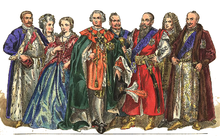
Nobility might be either inherited or conferred by afons honorum.It is usually an acknowledged preeminence that is hereditary, i.e. the status descends exclusively to some or all of thelegitimate,and usuallymale-line,descendants of a nobleman. In this respect, the nobility as a class has always been much more extensive than theprimogeniture-based titled nobility, which includedpeerages in Franceandin the United Kingdom,grandezasin Portugal and Spain, and some noble titles in Belgium, Italy, the Netherlands, Prussia and Scandinavia. In Russia, Scandinavia and non-Prussian Germany, titles usually descended to all male-line descendants of the original titleholder, including females. In Spain, noble titles are now equally heritable by females and males alike. Noble estates, on the other hand, gradually came to descend byprimogeniturein much of western Europe aside from Germany. In Eastern Europe, by contrast, with the exception of a fewHungarianestates, they usually descended to all sons or even all children.[10]
In France, some wealthybourgeois,most particularly the members of the variousparlements,were ennobled by the king, constituting thenoblesse de robe.The old nobility oflandedorknightlyorigin, thenoblesse d'épée,increasingly resented the influence and pretensions of thisparvenunobility. In the last years of theancien régimethe old nobility pushed for restrictions of certain offices andorders of chivalryto noblemen who could demonstrate that their lineage had extended "quarterings",i.e. several generations of noble ancestry, to be eligible for offices and favours atcourtalong with nobles ofmedievaldescent, although historians such asWilliam Doylehave disputed this so-called "Aristocratic Reaction".[11]Various court and military positions were reserved by tradition for nobles who could "prove" an ancestry of at leastseize quartiers(16 quarterings), indicating exclusively noble descent (as displayed, ideally, in the family'scoat of arms) extending back five generations (all 16 great-great-grandparents).

in the typical dress of theHungarian nobility,18th century
This illustrates the traditional link in many countries betweenheraldryand nobility; in those countries where heraldry is used, nobles have almost always beenarmigerous,and have used heraldry to demonstrate their ancestry andfamily history.However, heraldry has never been restricted to the noble classes in most countries, and being armigerous does not necessarily demonstrate nobility.Scotland,however, is an exception.[12]In a number of recent cases in Scotland the Lord Lyon King of Arms has controversially (vis-à-visScotland's Salic law) granted the arms and allocated the chiefships of medieval noble families to female-line descendants of lords, even when they were not of noble lineage in the male line, while persons of legitimate male-line descent may still survive (e.g. the modernChiefs of Clan MacLeod).
In some nations,hereditary titles,as distinct from noble rank, were not always recognised in law, e.g., Poland'sSzlachta.European ranks of nobility lower thanbaronor its equivalent, are commonly referred to as thepetty nobility,althoughbaronetsof the British Isles are deemed titledgentry.Most nations traditionally had an untitled lower nobility in addition to titled nobles. An example is thelanded gentryof theBritish Isles.[13][14]Unlike England's gentry, theJunkersof Germany, thenoblesse de robeof France, thehidalgosof Spain and thenobiliof Italy were explicitly acknowledged by the monarchs of those countries as members of the nobility, although untitled. In Scandinavia, theBeneluxnations and Spain there are still untitled as well as titled families recognised in law as noble.
In Hungary members of the nobility always theoretically enjoyed the same rights. In practice, however, a noble family's financial assets largely defined its significance. Medieval Hungary's concept of nobility originated in the notion that nobles were "free men", eligible to own land.[15]This basic standard explains why the noble population was relatively large, although the economic status of its members varied widely. Untitled nobles were not infrequently wealthier than titled families, while considerable differences in wealth were also to be found within the titled nobility. The custom of granting titles was introduced to Hungary in the 16th century by theHouse of Habsburg.Historically, once nobility was granted, if a nobleman served the monarch well he might obtain the title of baron, and might later be elevated to the rank of count. As in other countries of post-medieval central Europe, hereditary titles were not attached to a particular land or estate but to the noble family itself, so that all patrilineal descendants shared a title of baron or count (cf.peerage). Neither nobility nor titles could be transmitted through women.[16]
Somecon artistssellfake titles of nobility,often with impressive-looking documentation. This may be illegal, depending on local law. They are more often illegal in countries that actually have nobilities, such as European monarchies. In the United States, such commerce may constitute actionablefraudrather than criminalusurpationof an exclusive right to use of any given title by an established class.[citation needed]
Other terms[edit]

"Aristocrat" and "aristocracy", in modern usage, refercolloquiallyand broadly to persons who inherit elevated social status, whether due to membership in the (formerly) official nobility or the moniedupper class.
Blue bloodis anEnglish idiomrecorded since 1811 in the Annual Register[17]and in 1834[18]for noble birth or descent; it is also known as a translation of the Spanish phrasesangre azul,which described the Spanishroyal familyand high nobility who claimed to be ofVisigothicdescent,[19]in contrast to theMoors.[20]The idiom originates from ancient and medieval societies of Europe and distinguishes anupper class(whosesuperficial veinsappeared blue through their untanned skin) from aworking classof the time. The latter consisted mainly of agricultural peasants who spent most of their time working outdoors and thus had tanned skin, through which superficial veins appear less prominently.
Robert Laceyexplains the genesis of the blue blood concept:
It was the Spaniards who gave the world the notion that an aristocrat's blood is not red but blue. The Spanish nobility started taking shape around the ninth century in classic military fashion, occupying land as warriors on horseback. They were to continue the process for more than five hundred years, clawing back sections of the peninsula from its Moorish occupiers, and a nobleman demonstrated his pedigree by holding up his sword arm to display the filigree of blue-blooded veins beneath his pale skin—proof that his birth had not been contaminated by the dark-skinned enemy.[21]
Africa[edit]
Africa has a plethora of ancient lineages in its various constituent nations. Some, such as the numeroussharifianfamilies of North Africa, theKeita dynastyofMali,theSolomonic dynastyofEthiopia,theDe Souza familyofBenin,theZulfikar familyofEgyptand theSherbro Tuckerclan ofSierra Leone,claim descent from notables from outside of the continent. Most, such as those composed of thedescendants of Shakaandthose of MoshoeshoeofSouthern Africa,belong to peoples that have been resident in the continent for millennia. Generally their royal or noble status is recognized by and derived from the authority of traditional custom. A number of them also enjoy either a constitutional or a statutory recognition of their high social positions.
Ethiopia[edit]
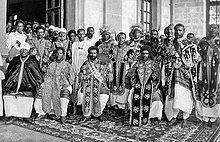
Ethiopiahas anobilitythat is almost as old as the country itself. Throughout the history of theEthiopian Empiremost of the titles of nobility have been tribal or military in nature. However the Ethiopian nobility resembled its European counterparts in some respects; until 1855, whenTewodros IIended theZemene Mesafintits aristocracy was organised similarly to the feudal system in Europe during the Middle Ages. For more than seven centuries, Ethiopia (orAbyssinia,as it was then known) was made up of many small kingdoms, principalities, emirates andimamates,which owed their allegiance to thenəgusä nägäst(literally "King of Kings" ). Despite its being a Christian monarchy, various Muslim states paid tribute to the emperors of Ethiopia for centuries: including theAdal Sultanate,theEmirate of Harar,and theAwsa sultanate.
Ethiopian nobility were divided into two different categories:Mesafint( "prince" ), the hereditary nobility that formed the upper echelon of the ruling class; and theMekwanin( "governor" ) who were appointed nobles, often of humble birth, who formed the bulk of the nobility (cf.theMinisterialisof theHoly Roman Empire). In Ethiopia there were titles of nobility among theMesafintborne by those at the apex of medieval Ethiopian society. The highest royal title (after that of emperor) wasNegus( "king" ) which was held by hereditary governors of the provinces ofBegemder,Shewa,Gojjam,andWollo.The next highest seven titles wereRas,Dejazmach,Fit'awrari,Grazmach,Qenyazmach,AzmachandBalambaras.The title ofLe'ul Raswas accorded to the heads of various noble families andcadet branchesof theSolomonic dynasty,such as the princes of Gojjam, Tigray, and Selalle. The heirs of theLe'ul Raseswere titledLe'ul Dejazmach,indicative of the higher status they enjoyed relative toDejazmacheswho were not of the blood imperial. There were varioushereditary titlesin Ethiopia: including that ofJantirar,reserved for males of the family of EmpressMenen Asfawwho ruled over the mountain fortress ofAmbasselin Wollo;Wagshum,a title created for the descendants of the deposedZagwe dynasty;andShum Agame,held by the descendants ofDejazmachSabagadis,who ruled over theAgamedistrict of Tigray. The vast majority of titles borne by nobles were not, however, hereditary.
Despite being largely dominated by Christian elements, some Muslims obtainedentréeinto the Ethiopian nobility as part of their quest for aggrandizement during the 1800s. To do so they were generally obliged to abandon their faith and some are believed to have feigned conversion to Christianity for the sake of acceptance by the old Christian aristocratic families. One such family, the Wara Seh (more commonly called the "Yejju dynasty" ) converted to Christianity and eventually wielded power for over a century, ruling with the sanction of the Solomonic emperors. The last such Muslim noble to join the ranks of Ethiopian society wasMikael of Wollowho converted, was madeNegusof Wollo, and later King of Zion, and even married into the Imperial family. He lived to see his son,Lij Iyasu,inherit the throne in 1913—only to be deposed in 1916 because of his conversion to Islam.
Madagascar[edit]

The nobility inMadagascarare known as theAndriana.In much of Madagascar, before French colonization of the island, theMalagasy peoplewere organised into a rigid social caste system, within which theAndrianaexercised both spiritual and political leadership. The word "Andriana" has been used to denote nobility in various ethnicities in Madagascar: including theMerina,theBetsileo,theBetsimisaraka,theTsimihety,theBezanozano,theAntambahoakaand theAntemoro.
The wordAndrianahas often formed part of the names of Malagasy kings, princes and nobles. Linguistic evidence suggests that the origin of the titleAndrianais traceable back to an ancientJavanesetitle of nobility. Before the colonization by France in the 1890s, theAndrianaheld various privileges, including land ownership, preferment for senior government posts, free labor from members of lower classes, the right to have their tombs constructed within town limits, etc. TheAndrianararely married outside their caste: a high-ranking woman who married a lower-ranking man took on her husband's lower rank, but a high-ranking man marrying a woman of lower rank did not forfeit his status, although his children could not inherit his rank or property (cf.morganatic marriage).
In 2011, the Council of Kings and Princes of Madagascar endorsed the revival of a ChristianAndrianamonarchy that would blend modernity and tradition.
Nigeria[edit]

ContemporaryNigeriahas aclass of traditional notableswhich is led by its reigning monarchs, theNigerian traditional rulers.Though their functions are largely ceremonial, the titles of the country's royals and nobles are often centuries old and are usually vested in the membership of historically prominent families in the varioussubnational kingdoms of the country.
Membership of initiatory societies that have inalienable functions within the kingdoms is also a common feature of Nigerian nobility, particularly among the southern tribes, where such figures as theOgboniof theYoruba,theNze na Ozoof theIgboand theEkpeof theEfikare some of the most famous examples. Although many of their traditional functions have become dormant due to the advent of modern governance, their members retain precedence of a traditional nature and are especially prominent during festivals.
Outside of this, many of the traditional nobles of Nigeria continue to serve asprivy counsellorsandviceroysin the service of their traditional sovereigns in a symbolic continuation of the way that their titled ancestors and predecessors did during the pre-colonial and colonial periods. Many of them are also members of the country'spolitical elitedue to their not being covered by the prohibition from involvement in politics that governs the activities of the traditional rulers.
Holding achieftaincytitle, either of thetraditionalvariety (which involves taking part in ritual re-enactments of your title's history during annual festivals, roughly akin to a Britishpeerage) or the honorary variety (which does not involve the said re-enactments, roughly akin to aknighthood), grants an individual the right to use the word "chief" as a pre-nominalhonorificwhile in Nigeria.
Asia[edit]
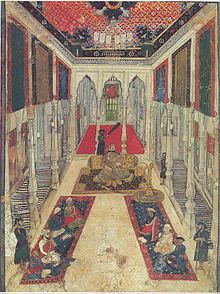
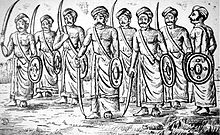


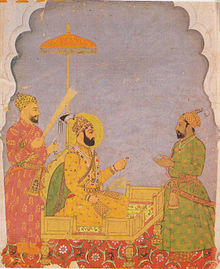
India, Pakistan, Bangladesh, and Nepal[edit]
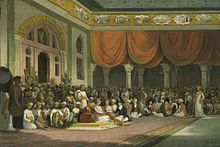
HistoricallyRajputsformed a class of aristocracy associated withwarriorhood,developing after the 10th century in theIndian subcontinent.During theMughal era,a class of administrators known asNawabsemerged who initially served as governors ofprovinces,later becoming independent. In theBritish Raj,many members of the nobility were elevated to royalty as they became the monarchs of their princely states, but as many princely state rulers were reduced from royals to noblezamindars.Hence, many nobles in the subcontinent had royal titles of Raja, Rai, Rana, Rao, etc. In Nepal,Kaji(Nepali:काजी) was a title and position used by nobility ofGorkha Kingdom(1559–1768) andKingdom of Nepal(1768–1846). HistorianMahesh Chandra Regmisuggests thatKajiis derived from Sanskrit wordKaryiwhich meant functionary.[22]Other noble and aristocratic titles wereThakur,Sardar,Jagirdar,Mankari,Dewan,Pradhan, Kaji etc.
China[edit]
InEast Asiathe system was often modelled on imperial China, the leading culture. Emperors conferredtitles of nobility.Imperial descendants formed the highest class of ancient Chinese nobility, their status based upon the rank of the empress or concubine from which they descend maternally (as emperors were polygamous). Numerous titles such asTaizi(crown prince), and equivalents of "prince" were accorded, and due to complexities indynasticrules,ruleswere introduced for Imperial descendants. The titles of the junior princes were gradually lowered in rank by each generation while the senior heir continued to inherit their father's titles.
It was a custom in China for the new dynasty to ennoble and enfeoff a member of the dynasty which they overthrew with a title of nobility and a fief of land so that they could offer sacrifices to their ancestors, in addition to members of other preceding dynasties.
China had a feudal system in theShangandZhou dynasties,which gradually gave way to a more bureaucratic one beginning in theQin dynasty(221 BC). This continued through theSong dynasty,and by its peak power shifted from nobility to bureaucrats.
This development was gradual and generally only completed in full by the Song dynasty. In theHan dynasty,for example, even though noble titles were no longer given to those other than the emperor's relatives, the fact that the process of selecting officials was mostly based on a vouching system by current officials as officials usually vouched for their own sons or those of other officials meant that a de facto aristocracy continued to exist. This process was further deepened during theThree Kingdomsperiod with the introduction of theNine-rank system.
By theSui dynasty,however, the institution of theImperial examinationsystem marked the transformation of a power shift towards a full bureaucracy, though the process would not be truly completed until the Song dynasty.
Titles of nobility became symbolic along with a stipend while governance of the country shifted to scholar officials.
In theQing dynastytitles of nobility were still granted by the emperor, but served merely as honorifics based on a loose system of favours to the Qing emperor.
Under a centralized system, the empire's governance was the responsibility of the Confucian-educated scholar-officials and the local gentry, while theliteratiwere accorded gentry status. For male citizens, advancement in status was possible via garnering the top three positions in imperial examinations.
The Qing appointed the Ming imperial descendants to the title ofMarquis of Extended Grace.
The oldest held continuous noble title in Chinese history was that held by the descendants ofConfucius,asDuke Yansheng,which was renamed as the Sacrificial Official to Confucius in 1935 by theRepublic of China.The title is held byKung Tsui-chang.There is also a "Sacrificial Official to Mencius" for a descendant ofMencius,a "Sacrificial Official to Zengzi" for a descendant ofZengzi,and a "Sacrificial Official to Yan Hui" for a descendant ofYan Hui.
The bestowal of titles was abolished upon the establishment of thePeople's Republic of Chinain 1949, as part of a larger effort to remove feudal influences and practises from Chinese society.
Korea[edit]
Unlike China, Silla's bone nobles were much more aristocratic and had the right to collect taxes and rule over people. They also thought of the king as Buddha and justified their rule through the idea that status was determined by birth.[23][24]However, this strict sense of social status gradually weakened due to the introduction of Confucianism and opposition from the lower class, and even in Silla, opportunities were given to people of low social status through Confucian tests such as '독서삼품과( độc thư tam phẩmKhoa)'.
However, the still strict status order of Silla caused opposition from many people and collapsed when the country moved to Goryeo. In Goryeo, powerful families along with existing nobles became nobles, claiming a new lineage nobility. And in Goryeo, dissatisfied lower class people confronted the nobles and took power for a short period of time. Goryeo also had many hereditary families, and they were more aristocratic than Confucian bureaucrats, forcibly collecting taxes from the people being slaughtered by the Mongolian army, killing those who rebelled, and writing poetry ignoring their situation.
As Goryeo weakened and nobles pursuing Joseon appeared, Goryeo's nobility could not stand against them and chose to be absorbed into yangban. However, since the Korean nobility had never experienced defeat by commoners like Han Gaozu Liu Bang, the aristocratic character was not completely extinguished even in Joseon, which began to actively introduce Han Chinese rule. So, in the early days, there were quite a few hereditary powerful noblemen like the Jeju Ko.[25]However, as Confucian reforms continued, it became difficult for yangbans to obtain political positions if they did not pass the exam. Each of them was usually still superior to ordinary people, but was not recognized unless it passed the test. So now, in order to become a yangban, it was essential for the members to pass the exam.
Islamic world[edit]
In some Islamic countries, there are no definite noble titles (titles of hereditary rulers being distinct from those of hereditary intermediaries between monarchs and commoners). Persons who can trace legitimate descent fromMuhammador the clans ofQuraysh,as can members of several present or formerly reigning dynasties, are widely regarded as belonging to the ancient, hereditary Islamic nobility. In some Islamic countries they inherit (through mother or father) hereditary titles, although without any other associated privilege, e.g., variations of the titleSayyidandSharif.Regarded as more religious than the general population, many people turn to them for clarification or guidance in religious matters.

InIran,historical titles of the nobility includingMirza,Khan,ed-DowlehandShahzada( "Son of a Shah), are now no longer recognised. An aristocratic family is now recognised by theirfamily name,often derived from the post held by their ancestors, considering the fact that family names in Iran only appeared in the beginning of the 20th century. Sultans have been an integral part of Islamic history. See:Zarabi During theOttoman Empirein the Imperial Court and the provinces there were manyOttoman titles and appellationsforming a somewhat unusual and complex system in comparison with the other Islamic countries. The bestowal of noble and aristocratic titles was widespread across the empire even after its fall by independent monarchs. One of the most elaborate examples is that of the Egyptian aristocracy's largest clan, theAbaza family,of maternalAbazinandCircassianorigin.[26][27][28][29]
Japan[edit]


Medieval Japan developed a feudal system similar to the European system, where land was held in exchange for military service. Thedaimyōclass, or hereditary landowning nobles, held great socio-political power. As in Europe, they commanded private armies made up ofsamurai,an elitewarrior class;for long periods, these held the real power without a realcentral government,and often plunged the country into a state of civil war. Thedaimyōclass can be compared to European peers, and the samurai to European knights, but important differences exist.
Following theMeiji Restorationin 1868, feudal titles and ranks were reorgnised into thekazoku,a five-rankpeeragesystem after the British example, which granted seats in the upper house of theImperial Diet;this ended in 1947 following Japan's defeat in World War II.
Philippines[edit]
Like other Southeast Asian countries, many regions in thePhilippineshave indigenous nobility, partially influenced by Hindu, Chinese, and Islamic custom. Since ancient times,Datuwas the common title of a chief or monarch of the manypre-colonialprincipalities and sovereign dominions throughout the isles; in some areas the termApowas also used.[30]With the titlesSultanandRajah,Datu(and itsMalaycognate,Datok) are currently used in some parts of the Philippines,Indonesia,MalaysiaandBrunei.These titles are the rough equivalents of European titles, albeit dependent on the actual wealth and prestige of the bearer.
Recognition by the Spanish Crown[edit]
Upon theislands' Christianisation,the datus retained governance of their territories despite annexation to theSpanish Empire.In a law signed 11 June 1594,[31]KingPhilip II of Spainordered that the indigenous rulers continue to receive the same honours and privileges accorded them prior their conversion toCatholicism.The baptised nobility subsequently coalesced into the exclusive, landed ruling class of the lowlands known as thePrincipalía.[32]
On 22 March 1697, KingCharles II of Spainconfirmed the privileges granted by his predecessors (in Title VII, Book VI of theLaws of the Indies)[33]to indigenous nobilities of the Crown colonies, including thePrincipalesof the Philippines, and extended to them and to their descendants the preeminence and honors customarily attributed to theHidalgosofCastile.[34]
Filipino nobles during the Spanish era[edit]
TheLaws of the Indiesand other pertinent Royal Decrees were enforced in the Philippines and benefited many indigenous nobles. It can be seen very clearly and irrefutably that, during the colonial period, indigenous chiefs were equated with theSpanish Hidalgos,and the most resounding proof of the application of this comparison is the General Military Archive inSegovia,where the qualifications of "Nobility" (found in the Service Records) are attributed to those Filipinos who were admitted to the Spanish Military Academies and whose ancestors werecaciques,encomenderos,notable Tagalogs, chieftains,governorsor those who held positions in the municipal administration or government in all different regions of the large islands of the Archipelago, or of the many small islands of which it is composed.[35]In the context of the ancient tradition and norms of Castilian nobility, all descendants of a noble are considered noble, regardless of fortune.[36]

At theReal Academia de la Historia,there is a substantial number of records providing reference to the Philippine Islands, and while most parts correspond to the history of these islands, theAcademiadid not exclude among its documents the presence of many genealogical records. The archives of theAcademiaand its royal stamp recognized the appointments of hundreds of natives of the Philippines who, by virtue of their social position, occupied posts in the administration of the territories and were classified as"nobles".[37]The presence of these notables demonstrates the cultural concern of Spain in those Islands to prepare the natives and the collaboration of these in the government of the Archipelago. This aspect of Spanish rule in the Philippines appears much more strongly implemented than in theAmericas.Hence in the Philippines, the local nobility, by reason of charge accorded to their social class, acquired greater importance than in theIndiesof theNew World.[38]
With the recognition of the Spanish monarchs came the privilege of being addressed asDonorDoña,[39]a mark of esteem and distinction in Europe reserved for a person of noble or royal status during the colonial period. Other honors and high regard were also accorded to the Christianized Datus by theSpanish Empire.For example, theGobernadorcillos(elected leader of theCabezas de Barangayor the Christianized Datus) and Filipino officials of justice received the greatest consideration from the Spanish Crown officials. The colonial officials were under obligation to show them the honor corresponding to their respective duties. They were allowed to sit in the houses of the Spanish Provincial Governors, and in any other places. They were not left to remain standing. It was not permitted for Spanish Parish Priests to treat these Filipino nobles with less consideration.[40]
The Gobernadorcillos exercised the command of the towns. They were Port Captains in coastal towns. They also had the rights and powers to elect assistants and several lieutenants andalguaciles,proportionate in number to the inhabitants of the town.[41]
Currentstatus questionis[edit]

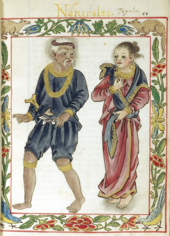
The recognition of the rights and privileges accorded to the Filipino Principalía asHijosdalgosofCastileseems to facilitate entrance of Filipino nobles into institutions of under the Spanish Crown, either civil or religious, which required proofs of nobility.[42]: 235 However, to see such recognition as an approximation or comparative estimation of rank or status might not be correct since in reality, although the principales were vassals of the Crown, their rights as sovereign in their former dominions were guaranteed by theLaws of the Indies,more particularly the Royal Decree of Philip II of 11 June 1594, which Charles II confirmed for the purpose stated above in order to satisfy the requirements of the existing laws in the Peninsula.
It must be recalled that ever since the beginning of the colonialization, the conquistadorMiguel López de Legazpidid not strip the ancient sovereign rulers of the Archipelago (who vowed allegiance to the Spanish Crown) of their legitimate rights. Many of them accepted the Catholic religion and were his allies from the very beginning. He only demanded from these local rulersvassalageto the Spanish Crown,[43]replacing the similaroverlordship,which previously existed in a few cases, e.g.,Sultanate of Brunei's overlordship of theKingdom of Maynila.Other independentpolitieswhich were not vassals to other States, e.g.,Confederation of Madja-asand theRajahnate of Cebu,were more ofProtectorates/Suzeraintieshaving had alliances with the Spanish Crown before the Kingdom took total control of most parts of the Archipelago.
Europe[edit]
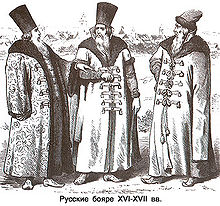
European nobility originated in the feudal/seignorial system that arose in Europe during theMiddle Ages.[44]Originally,knightsor nobles were mounted warriors who swore allegiance to their sovereign and promised to fight for him in exchange for an allocation of land (usually together withserfsliving thereon). During the period known as theMilitary Revolution,nobles gradually lost their role in raising and commanding private armies, as many nations created cohesive national armies.
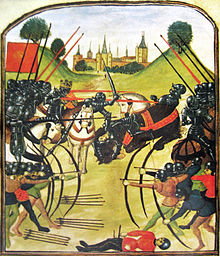
This was coupled with a loss of the socio-economic power of the nobility, owing to the economic changes of theRenaissanceand the growing economic importance of the merchant classes, which increased still further during theIndustrial Revolution.In countries where the nobility was the dominant class, thebourgeoisiegradually grew in power; a rich city merchant came to be more influential than a nobleman, and the latter sometimes sought inter-marriage with families of the former to maintain their noble lifestyles.[45]
However, in many countries at this time, the nobility retained substantial political importance and social influence: for instance, the United Kingdom's government was dominated by the (unusually small) nobility until the middle of the 19th century. Thereafter the powers of the nobility were progressively reduced by legislation. However, until 1999, allhereditary peerswere entitled to sit and vote in theHouse of Lords.Since then, only 92 of them have this entitlement, of whom 90 are elected by the hereditary peers as a whole torepresent the peerage.
The countries with the highest proportion of nobles werePolish–Lithuanian Commonwealth(15% of an 18th-century population of 800,000[citation needed]),Castile(probably 10%), Spain (722,000 in 1768 which was 7–8% of the entire population) and other countries with lower percentages, such as Russia in 1760 with 500,000–600,000 nobles (2–3% of the entire population), and pre-revolutionaryFrancewhere there were no more than 300,000 prior to 1789, which was 1% of the population (although some scholars believe this figure is an overestimate). In 1718 Sweden had between 10,000 and 15,000 nobles, which was 0.5% of the population. In Germany it was 0.01%.[46]
In theKingdom of Hungarynobles made up 5% of the population.[47]All the nobles in 18th-century Europe numbered perhaps 3–4 million out of a total of 170–190 million inhabitants.[48][49]By contrast, in 1707, whenEngland and Scotland unitedinto Great Britain, there were only 168English peers,and 154Scottish ones,though their immediate families were recognised as noble.[50]
Apart from the hierarchy of noble titles, in England rising through baron, viscount, earl, and marquess to duke, many countries had categories at the top or bottom of the nobility. Thegentry,relatively smalllandownerswith perhaps one or two villages, were mostly noble in most countries, for example thePolish landed gentry.At the top, Poland hada far smaller class of "magnates",who were hugely rich and politically powerful. In other countries the small groups of SpanishGrandeeorPeer of Francehad great prestige but little additional power.
Latin America[edit]
In addition to the nobility of a variety of native populations in what is now Latin America (such as theAymara,Aztecs,Maya,andQuechua) who had long traditions of being led by monarchs and nobles, peerage traditions dating to the colonial and post-colonial imperial periods (in the case of such countries asMexicoandBrazil), have left noble families in each of them that have ancestral ties to those nations' Indigenous and European families, especially theSpanish nobility,but also thePortugueseandFrenchnobility.
Bolivia[edit]

From the many historical native chiefs and rulers of pre-ColumbianBoliviato theCriolloupper classthat dates to the era ofcolonial Boliviaand that has ancestral ties to theSpanish nobility,Bolivia has several groups that may fit into the category of nobility.
For example, there is a ceremonialmonarchyled by a titular ruler who is known as theAfro-Bolivian king.The members of his dynasty are the direct descendants of an oldAfrican tribal monarchythat were brought to Bolivia as slaves. They have provided leadership to theAfro-Bolivian communityever since that event and have been officially recognized by Bolivia's government since 2007.[51]
Brazil[edit]

The nobility in Brazil began during thecolonial erawith thePortuguese nobility.When Brazil became aunited kingdom with Portugalin 1815, the firstBrazilian titles of nobilitywere granted by the king of Portugal, Brazil and the Algarves.
With the independence of Brazil in 1822 as a constitutional monarchy, the titles of nobility initiated by the king of Portugal were continued and new titles of nobility were created by theemperor of Brazil.However, according to theBrazilian Constitution of 1824,the emperor conferred titles of nobility, which were personal and therefore non-hereditary, unlike the earlier Portuguese and Portuguese-Brazilian titles, being inherited exclusively to the royal titles of theBrazilian imperial family.[citation needed]
During the existence of theEmpire of Brazil,1,211 noble titles were acknowledged.[citation needed]With the proclamation of theFirst Brazilian Republic,in 1889, the Brazilian nobility was discontinued. It was also prohibited, under penalty of accusation ofhigh treasonand the suspension of political rights, to accept noble titles and foreign decorations without the proper permission of the state. In particular, the nobles of greater distinction, by respect and tradition, were allowed to use their titles during the republican regime. The imperial family also could not return to the Brazilian soil until 1921, when the Banishment Law was repealed.[citation needed]
Mexico[edit]
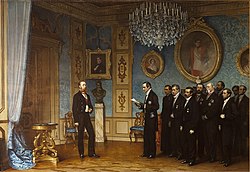
The Mexican nobility were ahereditarynobility ofMexico,with specific privileges and obligations determined in the variouspolitical systemsthat historically ruled over the Mexican territory.
The term is used in reference to various groups throughout the entirety of Mexican history, from formerlyrulingindigenousfamilies of thepre-Columbianstates of present-dayMexico,to noble Mexican families ofSpanish,mestizo,and otherEuropeandescent, which includeconquistadorsand theirdescendants(ennobled by KingPhilip IIin1573), untitled noble families of Mexico, and holders oftitles of nobilityacquired during theViceroyalty of the New Spain(1521–1821), theFirst Mexican Empire(1821–1823), and theSecond Mexican Empire(1862–1867); as well as bearers of titles and other nobleprerogativesgranted by foreign powers who have settled in Mexico.
ThePolitical Constitution of Mexicohas prohibited the state from recognizing anytitles of nobilitysince 1917. The presentUnited Mexican Statesdoes not issue or recognize titles of nobility or any hereditary prerogatives and honors. Informally, however, a Mexican aristocracy remains a part of Mexican culture and itshierarchicalsociety.
Nobility by nation[edit]
A list of noble titles for different European countries can be found atRoyal and noble ranks.
Africa[edit]
- Botswanan chieftaincy
- Burundian nobility
- Egyptian nobility
- Ethiopian nobility
- Ghanaian chieftaincy
- Malagasy nobility
- Malian nobility
- Nigerian chieftaincy
- Rwandan nobility
- Somali nobility
- Zimbabwean chieftaincy
America[edit]
- Canadian peers and baronets
- French-Canadian nobility
- Brazilian nobility
- Cuban nobility
- Kuraka (Peru)
- Mexican nobility
- United States – While itsconstitution barsthe federal and state governments from granting titles of nobility, in most cases citizens are not barred from accepting,holdingor inheriting them. And, since at least 1953, the U.S. requires applicants for naturalization to renounce any titles.[52]
Asia[edit]
- Armenian nobility
- Chinese nobility
- Indian peers and baronets
- Kaji (Nepal)
- Indonesian (Dutch East Indies) nobility
- Japanese nobility
- Burmese nobility
- Korean nobility
- Vietnamese nobility
- Malay nobility
- Mongolian nobility
- Ottoman titles
- Principalíaof the Philippines
- Thai nobility
Europe[edit]
- Albanian nobility
- Austrian nobility
- Baltic nobility– ethnicallyBaltic Germannobility in the modern area of Estonia and Latvia
- Belgian nobility
- British nobility
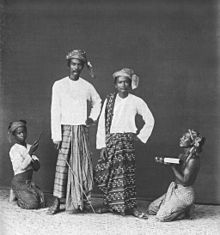
- Byzantine aristocracy and bureaucracy
- Croatian nobility
- Czech nobility
- Danish nobility
- Dutch nobility
- Finnish nobility
- French nobility
- German nobility
- Hungarian nobility
- Icelandic nobility
- Irish nobility
- Italian nobility
- Lithuanian nobility
- Maltese nobility
- Montenegrin nobility
- Norwegian nobility
- Polish nobility
- Portuguese nobility
- Russian nobility
- Ruthenian nobility
- Serbian nobility
- Spanish nobility
- Swedish nobility
- Swiss nobility
Oceania[edit]
See also[edit]
- Almanach de Gotha
- Aristocracy (class)
- Ascribed status
- Baig
- Caste(social hierarchy of India)
- Debutante
- False titles of nobility
- Gentleman
- Gentry
- Grand Burgher(German:Großbürger)
- Heraldry
- Honour
- Kaji (Nepal)
- King
- List of fictional nobility
- List of noble houses
- Magnate
- Nobiliary particle
- Noblesse oblige
- Noble women
- Nze na Ozo
- Ogboni
- Pasha
- Patrician (ancient Rome)
- Patrician (post-Roman Europe)
- Peerage
- Petty nobility
- Princely state
- Raja
- Redorer son blason
- Royal descent
- Social environment
- Symbolic capital
References[edit]
- ^"Move Over, Kate Middleton: These Commoners All Married Royals, Too".Vogue.Archivedfrom the original on 2018-10-25.Retrieved2018-10-24.
- ^Oliver, Revilo P.(1978)."Tacitean" Nobilitas ""(PDF).Illinois Classical Studies.3.University of Illinois Press:238–261.hdl:2142/11694.JSTOR23062619.Archived(PDF)from the original on 15 September 2018.Retrieved15 September2018.
- ^Bengtsson, Erik; Missiaia, Anna; Olsson, Mats; Svensson, Patrick (12 June 2018)."The Wealth of the Richest: Inequality and the Nobility in Sweden, 1750–1900"(PDF).Scandinavian Journal of History.Taylor & Francis:1–28.doi:10.1080/03468755.2018.1480538.S2CID149906044.Archived(PDF)from the original on 15 September 2018.Retrieved15 September2018– viaLund University Libraries.
- ^Lukowski, Jerzy(2003). Hall, Lesley; Lilley, Keith D.; MacMaster, Neil; Spellman, W. M.; Waite, Gary K.; Webb, Diana (eds.).The European Nobility in the Eighteenth Century(PDF).Palgrave Macmillan.p. 243.ISBN0-333-74440-3.Archived fromthe original(PDF)on 2018-09-15.Retrieved2018-09-15– via Zaccheus Onumba Dibiaezue Memorial Libraries.
- ^Country Life (magazine),Who really owns Britain?Archived2021-11-04 at theWayback Machine,16. October 2010.
- ^"Half of England is owned by less than 1% of the population".The Guardian.17 April 2019.Archivedfrom the original on 30 October 2021.Retrieved30 October2021.
- ^Chisholm, Hugh,ed. (1911)..Encyclopædia Britannica.Vol. 19 (11th ed.). Cambridge University Press. p. 728.
- ^Jonathan, Dewald (1996).The European nobility, 1400–1800.Cambridge University Press. p. 117.ISBN0-521-42528-X.Archivedfrom the original on 2022-04-07.Retrieved2015-10-23.
- ^Pine, L.G.(1992).Titles: How the King became His Highness.New York: Barnes & Noble Books. pp.77.ISBN978-1-56619-085-5.
- ^"The consolidation of Noble Power in Europe, c. 1600–1800".Archivedfrom the original on 2013-12-13.Retrieved2013-04-16.
- ^W. Doyle,Essays on Eighteenth Century France,London, 1995
- ^An opinion ofInnes of Learneydifferentiates the system in use in Scotland from many other European traditions, in that armorial bearings which are entered in the Public Register of All Arms and Bearings in Scotland by warrant of theLord LyonKing of Armsare legally "Ensigns of Nobility", and although the historical accuracy of that interpretation has beenchallengedArchived2010-01-09 at theWayback Machine,Innes of Learney's perspective is accepted in theStair Memorial Encyclopaediaentry, 'Heraldry' (Volume 11), 3, The Law of Arms. 1613. The nature of arms.
- ^Larence, Sir James Henry (1827) [first published 1824].The nobility of the British Gentry or the political ranks and dignities of the British Empire compared with those on the continent(2nd ed.). London: T.Hookham – Simpkin and Marshall.Archivedfrom the original on 2013-05-26.Retrieved2013-01-06.
- ^Ruling of the Court of the Lord Lyon (26/2/1948, Vol. IV, page 26): "With regard to the words 'untitled nobility' employed in certain recent birthbrieves in relation to the (Minor) Baronage of Scotland, Finds and Declares that the (Minor) Barons of Scotland are, and have been both in this nobiliary Court and in the Court of Session recognised as a 'titled nobility' and that the estait of the Baronage (i.e.,Barones Minores) are of the ancient Feudal Nobility of Scotland ". This title is not, however, apeerage,thus Scotland'snoblesseranks in England as gentry.
- ^Ölyvedi Vad Imre. (1930) Nemességi könyv. Koroknay-Nyomda. Szeged, Hungary. 45p.
- ^Ölyvedi Vad Imre. (1930) Nemességi könyv. Koroknay-Nyomda. Szeged, Hungary. 85.p
- ^"The annual register. v.51 1809".HathiTrust:813.Archivedfrom the original on 2021-09-25.Retrieved2020-09-15.
The nobility of Valencia..are, by themselves, divided into three classes, blue blood, red blood, and yellow blood. Blue blood is confined to families who have been made grandees.
- ^Edgeworth, Maria (1857)."Helen".Project Gutenberg.Archivedfrom the original on 2020-02-15.Retrieved2020-09-15.
One in particular, from Spain, of high rank and birth, of the sangre azul, the blue blood, who have the privilege of the silken cord if they should come to be hanged.
- ^The politics of aristocratic empires by John Kautsky.Transaction Publishers. January 1997.ISBN9781412838351.Archivedfrom the original on 2016-05-27.Retrieved2015-10-23.
- ^Malte-Brun, Conrad; Balbi, Adriano (1842).System of universal geography, founded on the works of Malte-Burn and Balbi; embracing a historical sketch of the progress of geographical discovery, the principles of mathematical and physical geography, and a complete description from the most recent sources, of the political and social condition of the world...Edinburgh; London: Adam and Charles Black; Longman, Brown, Green, & Longmans. p. 537.OCLC33328020.Archivedfrom the original on 2021-09-25.Retrieved2020-09-15.
The Spanish community is divided into two great castes, those of pure Gothic or blue blood, and those of mixed Gothic and Moorish descent, or black blood.
- ^Robert Lacey,Aristocrats.Little, Brown and Company, 1983, p. 67
- ^Regmi, Mahesh Chandra (1979).Regmi Research Series.Nepal. p. 43.
{{cite book}}:CS1 maint: location missing publisher (link) - ^"교과서 용어해설 | 우리역사넷".contents.history.go.kr.Retrieved2024-06-08.
- ^"우리역사넷".contents.history.go.kr.Retrieved2024-06-08.
- ^김, 종업,"탐라국 ( đam la quốc )",한국민족문화대백과사전 [Encyclopedia of Korean Culture](in Korean), Academy of Korean Studies,retrieved2024-06-08
- ^"عائلات تحكم مصر.. 1 ـ" الأباظية "عائلة الباشوات".albawabhnews.com.2014-03-26.Retrieved2024-04-03.
- ^CBCtwo (May 10, 2014).#مساء_الخير | محمود اباظة: حصلنا على لقب العيلة من سيدة شركسية.Retrieved2024-04-03– via YouTube.
- ^"عائلات بارزة تدفع بأبنائها في الانتخابات لحفظ الميراث النيابي | مصر العربية".2019-02-20. Archived fromthe originalon 2019-02-20.Retrieved2024-04-03.
- ^Sayyid-Marsot, Afaf Lutfi (2024-02-24).Egypt in the Reign of Muhammad Ali - Afaf Lutfi Sayyid-Marsot - Google Books.Cambridge University Press.ISBN978-0-521-28968-9.Retrieved2024-04-03.
- ^The Olongapo StoryArchived2020-02-19 at theWayback Machine,July 28, 1953 – Bamboo Breeze – Vol. 6, No. 3
- ^"It is not right that the Indian chiefs of Filipinas be in a worse condition after conversion; rather they should have such treatment that would gain their affection and keep them loyal, so that with the spiritual blessings that God has communicated to them by calling them to His true knowledge, the temporal blessings may be added and they may live contentedly and comfortably. Therefore, we order the governors of those islands to show them good treatment and entrust them, in our name, with the government of the Indians, of whom they were formerly lords. In all else the governors shall see that the chiefs are benefited justly, and the Indians shall pay them something as a recognition, as they did during the period of their paganism, provided it be without prejudice to the tributes that are to be paid us, or prejudicial to that which pertains to their encomenderos." Felipe II,Ley de Junio 11, 1594inRecapilación de leyes,lib. vi, tit. VII, ley xvi. Also cf.Emma Helen Blairand James Alexander Robertson,The Philippine Islands (1493–1898),Cleveland: The A.H. Clark Company, 1903, Vol. XVI, pp. 155–156.
- ^Scott, William Henry (1982). Cracks in the Parchment Curtain, and Other Essays in Philippine History. Quezon City: New Day Publishers.ISBN978-9711000004.OCLC9259667,p. 118.
- ^"Recopilación de Leyes de los Reynos de las Indias"(PDF).Archived(PDF)from the original on 2017-03-28.Retrieved2015-07-28.
- ^Por cuanto teniendo presentes las leyes y cédulas que se mandaron despachar por los Señores Reyes mis progenitores y por mí, encargo el buen tratamiento, amparo, protección y defensa de los indios naturales de la América, y que sean atendidos, mantenidos, favorecidos y honrados como todos los demás vasallos de mi Corona, y que por el trascurso del tiempo se detiene la práctica y uso de ellas, y siento tan conveniente su puntual cumplimiento al bien público y utilidad de los Indios y al servicio de Dios y mío, y que en esta consecuencia por lo que toca a los indios mestizos está encargo a los Arzobispos y Obispos de las Indias, por la Ley Siete, Título Siete, del Libro Primero, de la Recopilación, los ordenen de sacerdotes, concurriendo las calidades y circunstancias que en ella se disponen y que si algunas mestizas quisieren ser religiosas dispongan el que se las admita en los monasterios y a las profesiones, y aunque en lo especial de que quedan ascender los indios a puestos eclesiásticos o seculares, gubernativos, políticos y de guerra, que todos piden limpieza de sangre y por estatuto la calidad de nobles, hay distinción entre los Indios y mestizos, o como descendentes de los indios principales que se llaman caciques, o como procedidos de indios menos principales que son los tributarios, y que en su gentilidad reconocieron vasallaje, se considera que a los primeros y sus descendentes se les deben todas las preeminencias y honores, así en lo eclesiástico como en lo secular que se acostumbran conferir a los nobles Hijosdalgo de Castilla y pueden participar de cualesquier comunidades que por estatuto pidan nobleza, pues es constante que estos en su gentilismo eran nobles a quienes sus inferiores reconocían vasallaje y tributaban, cuya especie de nobleza todavía se les conserva y considera, guardándoles en lo posible, o privilegios, como así se reconoce y declara por todo el Título de los caciques, que es el Siete, del Libro Seis, de la Recopilación, donde por distinción de los indios inferiores se les dejó el señorío con nombre de cacicazgo, transmisible de mayor en mayor, a sus posterioridades...Cf. DE CADENAS Y VICENT, Vicente (1993).Las Pruebas de Nobleza y Genealogia en Filipinas y Los Archivios en Donde se Pueden Encontrar Antecedentes de EllasinHeraldica, Genealogia y Nobleza en los Editoriales de «Hidalguia»,19531–993: 40 años de un pensamiento (in Castellano). Madrid: HIDALGUIA, pp. 234-235.Archived2015-06-23 at theWayback Machine
- ^Por ella se aprecia bien claramente y de manera fehaciente que a los caciques indígenas se les equiparada a los Hidalgos españoles y la prueba más rotunda de su aplicación se halla en el Archivo General Militar de Segovia, en donde las calificaciones de «Nobleza» se encuentran en las Hojas de Servicio de aquellos filipinos que ingresaron en nuestras Academias Militares y cuyos ascendientes eran caciques, encomenderos, tagalos notables, pedáneos, por los gobernadores o que ocupan cargos en la Administración municipal o en la del Gobierno, de todas las diferentes regiones de las grandes islas del Archipiélago o en las múltiples islas pequeñas de que se compone el mismo.DE CADENAS Y VICENT, Vicente (1993).Las Pruebas de Nobleza y Genealogia en Filipinas y Los Archivios en Donde se Pueden Encontrar Antecedentes de Ellas in Heraldica, Genealogia y Nobleza en los Editoriales de "Hidalguia",1953–1993: 40 años de un pensamiento (in Spanish). Madrid: HIDALGUIA.ISBN9788487204548,p. 235.
- ^Ceballos-Escalera y Gila, Alfonso, ed. (2016).Los Saberes de la Nobleza Española y su Tradición: Familia, corte, librosinCuadernos de Ayala,N. 68 (Octubre-Diciembre 2016, p. 4
- ^Por otra parte, mientras en las Indias la cultura precolombiana había alcanzado un alto nivel, en Filipinas la civilización isleña continuaba manifestándose en sus estados más primitivos. Sin embargo, esas sociedades primitivas, independientes totalmente las unas de las otras, estaban en cierta manera estructuradas y se apreciaba en ellas una organización jerárquica embrionaria y local, pero era digna de ser atendida. Precisamente en esa organización local es, como siempre, de donde nace la nobleza. El indio aborigen, jefe de tribu, es reconocido como noble y las pruebas irrefutables de su nobleza se encuentran principalmente en las Hojas de Servicios de los militares de origen filipino que abrazaron la carrera de las Armas, cuando para hacerlo necesariamente era preciso demostrar el origen nobiliario del individuo.DE CADENAS Y VICENT, Vicente (1993).Las Pruebas de Nobleza y Genealogia en Filipinas y Los Archivios en Donde se Pueden Encontrar Antecedentes de Ellas in Heraldica, Genealogia y Nobleza en los Editoriales de "Hidalguia",1953–1993: 40 años de un pensamiento (in Spanish). Madrid: HIDALGUIA.ISBN9788487204548,p. 232.
- ^También en la Real Academia de la Historia existe un importante fondo relativo a las Islas Filipinas, y aunque su mayor parte debe corresponder a la Historia de ellas, no es excluir que entre su documentación aparezcan muchos antecedentes genealógicos… El Archivo del Palacio y en su Real Estampilla se recogen los nombramientos de centenares de aborígenes de aquel Archipiélago, a los cuales, en virtud de su posición social, ocuparon cargos en la administración de aquellos territorios y cuya presencia demuestra la inquietud cultural de nuestra Patria en aquéllas Islas para la preparación de sus naturales y la colaboración de estos en las tareas de su Gobierno. Esta faceta en Filipinas aparece mucho más actuada que en el continente americano y de ahí que en Filipinas la Nobleza de cargo adquiera mayor importancia que en las Indias.DE CADENAS Y VICENT, Vicente (1993).Las Pruebas de Nobleza y Genealogia en Filipinas y Los Archivios en Donde se Pueden Encontrar Antecedentes de Ellas in Heraldica, Genealogia y Nobleza en los Editoriales de "Hidalguia",1953–1993: 40 años de un pensamiento (in Spanish). Madrid: HIDALGUIA.ISBN9788487204548,p. 234.
- ^Durante la dominación española, elcacique,jefe de un barangay, ejercía funciones judiciales y administrativas. A los tres años tenía el tratamiento dedony se reconocía capacidad para ser gobernadorcillo.Enciclopedia Universal Ilustrada Europeo-Americana.VII. Madrid: Espasa-Calpe, S.A. 1921, p. 624.
- ^Blair, Emma Helen & Robertson, James Alexander, eds. (1903).The Philippine Islands, 1493–1898.Volume 27 of 55 (1636–37). Historical introduction and additional notes by Edward Gaylord Bourne; additional translations by Arthur B. Myrick. Cleveland, Ohio: Arthur H. Clark Company.ISBN978-1-333-01347-9.OCLC769945242."Explorations by early navigators, descriptions of the islands and their peoples, their history and records of the catholic missions, as related in contemporaneous books and manuscripts, showing the political, economic, commercial and religious conditions of those islands from their earliest relations with European nations to the close of the nineteenth century, pp. 296–297.
- ^Blair, Emma Helen & Robertson, James Alexander, eds. (1903).The Philippine Islands, 1493–1898.Volume 27 of 55 (1636–37). Historical introduction and additional notes by Edward Gaylord Bourbe; additional translations by Arthur B. Myrick. Cleveland, Ohio: Arthur H. Clark Company.ISBN978-1-333-01347-9.OCLC769945242."Explorations by early navigators, descriptions of the islands and their peoples, their history and records of the catholic missions, as related in contemporaneous books and manuscripts, showing the political, economic, commercial and religious conditions of those islands from their earliest relations with European nations to the close of the nineteenth century, pp. 329.
- ^DE CADENAS Y VICENT, Vicente(1993).Las Pruebas de Nobleza y Genealogia en Filipinas y Los Archivios en Donde se Pueden Encontrar Antecedentes de EllasinHeraldica, Genealogia y Nobleza en los Editoriales de "Hidalguia", 1953–1993: 40 años de un pensamiento(in Spanish). Madrid: HIDALGUIA.ISBN9788487204548.Archivedfrom the original on 2022-04-07.Retrieved2020-11-02.
- ^FERRANDO, Fr Juan & FONSECA OSA, Fr Joaquin (1870–1872).Historia de los PP. Dominicos en las Islas Filipinas y en las Misiones del Japon, China, Tung-kin y Formosa(Vol. 1 of 6 vols) (in Spanish). Madrid: Imprenta y esteriotipia de M Rivadeneyra, p. 146
- ^Karl Ferdinand Werner,Naissance de la noblesse. L'essor des élites politiques en Europe.Fayard, Paris 1998,ISBN2-213-02148-1.
- ^Marcassa, Stefania, Jérôme Pouyet, and Thomas Trégouët. "Marriage strategy among the European nobility."Explorations in Economic History75 (2020): 101303.onlineArchived2021-07-14 at theWayback Machine
- ^Jorn Leonhard, and Christian Wieland, eds.What Makes the Nobility Noble?: Comparative Perspectives from the Sixteenth to the Twentieth Century(2011).
- ^Jonathan, Dewald (1996).The European nobility, 1400–1800.Cambridge University Press. p. 25.ISBN0-521-42528-X.Archivedfrom the original on 2022-04-07.Retrieved2015-10-23.
- ^Jean, Meyer (1973).Noblesses et pouvoirs dans l'Europe d'Ancien Régime, Hachette Littérature.Hachette.ISBN9782346228201.Archivedfrom the original on 2022-04-07.Retrieved2020-11-02.
- ^Jean-Pierre, Labatut (1981).Les noblesses européennes de la fin du XVe siècle à la fin du XVIIIe siècle.Presses universitaires de France.ISBN9782130353447.Archivedfrom the original on 2022-04-07.Retrieved2020-11-02.
- ^Farnborough, T. E. May, 1st Baron(1896).Constitutional History of England since the Accession of George the Third,11th ed.Volume I, Chapter 5, pp. 273–281.Archived2008-06-22 at theWayback MachineLondon: Longmans, Green and Co.
- ^Rodríguez, Andres (19 January 2018)."El retorno del rey negro boliviano a sus raíces africanas".El País.Archivedfrom the original on 2020-11-09.Retrieved2020-03-07.
- ^"Chapter 2 – The Oath of Allegiance".U.S. Citizenship and Immigration Services.4 April 2023.Retrieved27 Jan2024.
External links[edit]
 family (P53)(seeuses)
family (P53)(seeuses)
- WW-Person,an on-line database of European noble genealogy (archived)
- Worldroots, a selection of art and genealogy of European nobility
- Worldwidewords
- Etymology OnLine
- Genesis of European Nobility
- A few notes about grants of titles of nobility by modern Serbian Monarchs

